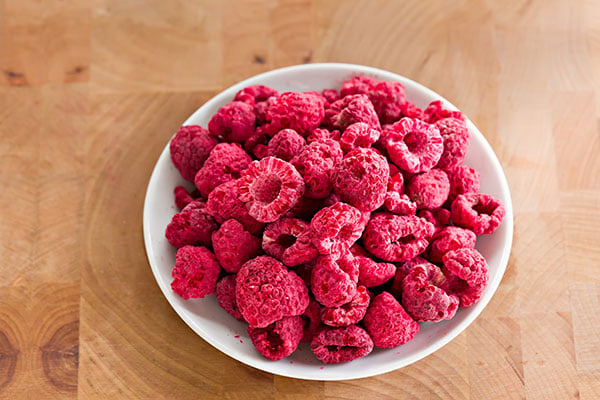 As with many food preservation techniques, freeze-drying was discovered by accident. Freeze-drying is thought to have first been used thousands of years ago in the Andes mountains, when the native Peruvians found that allowing potatoes to freeze in the cold overnight temperatures then quickly dry them in the scorching sun during the day drastically slowed spoilage.1 This method has been replicated and refined for modern use of creating shelf-stable products.
As with many food preservation techniques, freeze-drying was discovered by accident. Freeze-drying is thought to have first been used thousands of years ago in the Andes mountains, when the native Peruvians found that allowing potatoes to freeze in the cold overnight temperatures then quickly dry them in the scorching sun during the day drastically slowed spoilage.1 This method has been replicated and refined for modern use of creating shelf-stable products.
Using more sophisticated modern equipment, the freeze-dried food industry is growing. As of 2016, the global market for freeze-dried food was worth $46.9 billion, with an estimated compound annual growth rate (CAGR) of 7.01% from 2019-2023.2 This means burgeoning opportunity for manufacturers. Further, with an increase in the use of freeze-drying for biopharmaceuticals, further research on the details of the process and optimal conditions for freeze-drying is becoming readily available, as well as advancing technologies for the freezing and drying processes.3,4
Benefits of freeze-dried foods
There are several reasons why freeze-drying foods can be the optimal choice for preservation:1
- Produce such as berries can be harvested and freeze-dried at peak ripeness to capture maximal nutritional value. This makes freeze-dried products even more nutritious than some fresh products of the same type due to nutrient loss during early harvesting and shipping.
- Traditional dehydration also results in a dry, shelf-stable product, however, this food preservation method can damage or cause loss of some nutrients such as vitamins A and C.
- Freeze-dried yogurt retains healthy probiotics through the freeze-drying process, so that the probiotics are viable and beneficial for the consumer throughout the shelf life of the yogurt.
Interested in freeze-dried foods?
Search for freeze-dried foods quickly and easily with UL’s Prospector® platform. Find technical data and contact suppliers directly.
Search now
Formulation considerations
While there is certainly room for manufacturers to create a niche in the freeze-dried food market, there are some aspects to consider:
- Freeze-drying requires a great deal of energy compared to other food preservation methods. This may be a concern for some environmentally-conscious end consumers, depending on the type of energy used in production.5
- Freezing temperature and speed impact both drying time and the quality of the final product. It is important to consider the type of product being preserved in order to make appropriate adjustments.3
- Additives may change shelf-stability. For example, coffee is frequently freeze-dried, but in order to achieve the aroma that consumers desire that is native to freshly brewed coffee, coffee bean oil is added to freeze-dried coffee. Since the oil is not removed during the drying process, the possibility of rancidity of the oil makes the shelf life of the freeze-dried coffee shorter than it would otherwise have been.6
- While food items have typically been frozen individually in the past, a manufacturer in Israel is working on products that have many ingredients that are being freeze-dried together into one final product – specifically, snack bites.7 This technique of combining ingredients for freeze-drying opens up myriad possibilities.
- Packaging for freeze-dried foods must be airtight to prevent the product from absorbing moisture from the air, and air from inside the package must either be vacuumed out or replaced with an inert gas like nitrogen.6
It is clear that the freeze-dried foods market can welcome new manufacturers and products. While the concept of freeze-dried foods may bring to mind industrial foods, freeze-dried food products for end consumers are becoming more readily available and accepted, and technologies and research are helping to advance this food preservation method.
References
- http://www.mercerfoods.com/2016/03/08/health-benefits-of-freeze-dried/
- https://www.marketwatch.com/press-release/freeze-dried-food-market-2019-worldwide-overview-by-industry-size-market-share-future-trends-growth-factors-and-leading-players-research-report-analysis-2019-06-19
- https://www.tandfonline.com/doi/abs/10.1081/PDT-56308?src=recsys&journalCode=iphd20
- https://www.ncbi.nlm.nih.gov/pmc/articles/PMC6161129/
- https://www.motherjones.com/media/2011/07/freeze-dried-food-glenn-beck-tea-party/
- http://www.madehow.com/Volume-2/Freeze-Dried-Food.html
- https://www.foodnavigator.com/tag/keyword/Food/freeze%20dried
The views, opinions and technical analyses presented here are those of the author or advertiser, and are not necessarily those of ULProspector.com or UL Solutions. The appearance of this content in the UL Prospector Knowledge Center does not constitute an endorsement by UL Solutions or its affiliates.
All content is subject to copyright and may not be reproduced without prior authorization from UL Solutions or the content author.
The content has been made available for informational and educational purposes only. While the editors of this site may verify the accuracy of its content from time to time, we assume no responsibility for errors made by the author, editorial staff or any other contributor.
UL Solutions does not make any representations or warranties with respect to the accuracy, applicability, fitness or completeness of the content. UL Solutions does not warrant the performance, effectiveness or applicability of sites listed or linked to in any content.



A company in Utah sell freeze drying units The issue of air contact is handled thus. The food is stored in vacuum container or in heat sealed Mylar bags. The bags are silvered to prevent light deterioration. Also to manage the air issue in the bags the food is protected by oxygen adsorber packs. Oxygen is the problem with storage. Nitrogen in the bag is an inert gas already present.
I appreciate that this post mentioned that freeze-dried fruits will still have the same nutritional values as fresh fruits. My wife is an avid baker and she mentioned that she would like to have frozen fruits as the freshness will be preserved longer. I will heed your advice and consider supplier and recommend it to my wife.